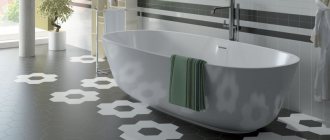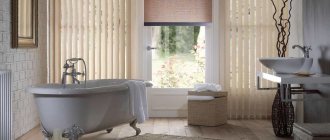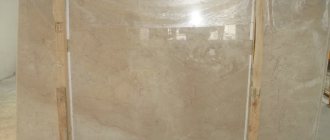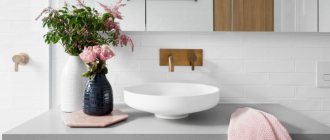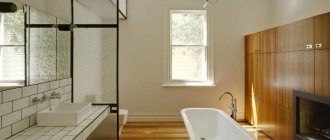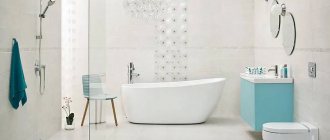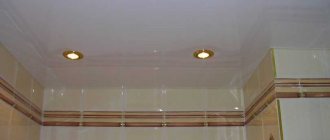How to choose floor tiles?
Tile, porcelain stoneware, ceramic and quartz vinyl tiles, waterproof laminate - high-quality materials on a moisture-resistant basis. They are laid out on the prepared surface from separate fragments.
Thanks to different options for laying tiles on the floor, it is easy to diversify the design of the bottom surface in the bathroom. The central part can be decorated with marble inserts, with a colored rosette, or laid out with a mosaic pattern made of broken ceramics.
Floor tiles have the greatest hardness and protection of the decorative surface. It is designed for passages and places with heavy mechanical load. The same article can be used not only for a bathroom in an apartment, but also in an indoor swimming pool.
Note! Even if the proposed imported sample does not have a translation, there are international designations. The foot on the packaging indicates “floor tiles.”
Today, potential buyers who prefer cladding with natural wood, marble or other stone are offered budget alternatives. Often, even a specialist cannot distinguish between parquet and quartz vinyl slats. The same is true with artificial marble, malachite or onyx - the noble pattern duplicates the wear-resistant porcelain stoneware.
Important requirements for bathroom tiles
Modern bathroom floor tiles do not require any special care like wood or marble. It is distinguished by high aesthetics and variability of textures. The functional coating must meet high performance requirements.
- High level of wear resistance. Marked with a sharp-toothed gear. For pulp, class 3-4 is suitable, class 5 is for rooms with increased floor load, class 1 is a wall-mounted option (marked in the shape of a palm).
- Moisture resistant. Bathroom floor tiles should not swell or become deformed from water.
- Heat resistance and fire resistance. This applies to all coatings in residential and adjacent rooms.
- Eco-safe. The coating should not contain harmful chemical components that are released when the surface gets wet and heated.
Note! Most varieties of moisture-resistant tiles are used in a heating system using an electrical cable in a “warm floor” scheme under the tiles.
- A high anti-slip coefficient is perhaps the most important indicator for safety. When leaving the bathroom with wet feet, it is important to be sure that the floor is not slippery. This is especially important for children and people with musculoskeletal problems. The icon on the packaging is a slanted line with a shoe. Classification from 1 to 4.
Secondary indicators of tile quality
The aesthetics of the cladding is also important, but everyone has their own preferences. For example, some people like a mirrored floor or ceiling, others have never been focused on such a floor design as in the photo of bathroom floor tiles in Leroy Merlin.
Durability is a secondary consideration, but no one wants to drop something heavy on the floor and find the slab cracked and peeling. The strongest replacement for tile is solid and ultra-durable porcelain tile. This is a relatively new material - the result of a violation of ceramic tile production technology. Today it is highly valued by tiling craftsmen.
Note!
- Epoxy grout for tiles: pros and cons, scope, varieties, how to work with it (instructions + photos)
- Do-it-yourself tile shower tray step by step: instructions, dimensions, design, installation of communications, types of structures, photos
- White tiles in the bathroom: 170 photos of the best ideas and new tile designs. Layout schemes and beautiful combinations
Important! Porcelain tiles imitate many natural materials. This is the most popular material for cladding exterior and interior spaces with changes in temperature and humidity. It cannot be cut with a tile cutter - machine waterjet cutting is required.
Latin letters and a flask mark tiles with high resistance to chemical reagents. It is important when cleaning large surfaces.
For example, when they prefer to put the same tiles on the floor in the bathtub and outdoor pool of a country house. This indicator confirms the homogeneity of the baked raw material or a hard protective coating that will not be damaged by alkalis, solvents and acids.
What are bathroom floor tiles made from?
When looking through catalogs of facing materials, people most often pay attention to the design and price per square meter. How not to make a mistake when choosing a type of moisture-resistant tile to lay on the bathroom floor with your own hands? There are many options here, even a specialist can get confused in the recommendations.
Common varieties:
- the “classic” ceramic base is not durable, it is made from clay with the addition of binding components, the cladding is available with great variability with multi-colored glazes;
- polymer tiles filled with stone chips - a durable floor covering that perfectly imitates granite and other “stone” surfaces;
- porcelain stoneware is a wear-resistant base made of clay with sand, baked in a special way during the production of ceramics, imitates natural materials;
- quartz vinyl, polymer base filled with fine sand, durable bathroom floor tiles in a marble look or with luxury wood decor, the top layer of which is protected from mechanical damage, installation with universal construction adhesive;
- clinker coating based on fireclay refractory clay, characterized by durability and resistance to high temperatures, suitable for cladding the floor adjacent to a fireplace, stove, chimney, or any hearth.
Summarizing the properties and aesthetics of the coating, it is easier to make a choice. Each variety has its own unique properties, pros and cons. It is important to take into account that the quality of installation directly depends on how level the base will be with waterproofing of the bathroom floor under the tiles.
Note!
Italian tiles for floors and walls: photos of beautiful tile designs in the bathroom and kitchen. Choosing tile color, style and size
- Marble tiles for the bathroom: TOP-200 photos of original design, ideas for mixing and matching
- Do-it-yourself tile shower step by step: instructions, algorithm of actions, dimensions, layout diagrams, photo of a shower with and without a tray
Types of tiles
The main types of floor tiles in the bathroom:
- Porcelain tiles are structurally homogeneous elements that provide special durability to the floor surface.
- Bicottura is a ceramic version made by pressing. Two layers of glaze provide not only an attractive appearance, but also special strength to each element.
- Monocottura - made by pressing. After firing it is covered with glaze. It has a low water absorption rate.
- Natural stone - granite, marble.
Porcelain tiles are the most durable option
Properties of floor covering types
The type of surface of a tiled floor directly depends on what properties a particular proposal is endowed with.
Textured (embossed, textured, rustic, structural) tiles on the bathroom floor look quite attractive. There is a very low chance that it will be slippery. The only negative is that there are problems with care; residues of soap solution, calcium and rust accumulate on the bumps and hollows of the pattern. In this segment there are always offers with a high anti-slip index (R 9).
Note! You can lay tiles on a wooden floor in a bathroom, sauna or bathhouse if you sand, waterproof and preserve them with a leveling mixture.
Glossy coatings are distinguished by their shine - the result of a high degree of light reflection. Mirror polymer tiles also fall into this category. Disadvantage - all dirt is visible, even on black coatings. Not the best solution for the kitchen and bathroom, but it looks great in a combined bathroom with a path made of other materials in the aisle.
Matte texture is a “classic” coating; it looks less impressive than mirror or glossy, but is the most practical. It has a wide variety of colors and does not require special care. Bathroom floor tiles are always in demand - the minimum price is 1 m2.
Note!
- Mosaic from broken tiles: step-by-step instructions on how to lay it out with your own hands (140 photo ideas)
Mosaic for the bathroom: TOP-150 photos of new designs, as well as modern ideas for combining mosaic tiles
Do-it-yourself water heated floor under tiles step by step: installation instructions with photos and descriptions, installation and connection
Choosing tile adhesive
When choosing an adhesive mixture for tiles, pay attention to the following aspects:
- Type of tile – tile or porcelain stoneware;
- Is there or is no floor heating;
- Type of base: solid screed or laid from sheets of wooden origin.
Based on these factors, the best composition is selected. Each tile manufacturer writes in its installation instructions about the recommended types of adhesive. To achieve the best results you need to follow them.
Color, decor and methods of laying tile coverings
When you get tired of the old tiles on the bathroom floor, look for a suitable modern finish. Today, the trend is “seamless installation”, for which special tiles without chamfer are used.
Precise cutting guarantees a minimum gap at the joints, filling with glue during installation, additionally treating with sealant (to guarantee insulation).
Tile variations differ in the type of color and shape of the fragments:
- square;
- 6-sided;
- 3-gon;
- octagon;
- rectangle.
These varieties are often combined. For example, the traditional installation of large marble-like slabs with sawn corners that fill the “crossroads” with small black “rivets” is popular.
It is good to alternate squares and rectangles of the same color when laying tiles on the floor in a chaotic manner with offset seams. All shades of water are suitable for rooms with high humidity, but everyone has their own preferences.
The combination of wood-look quartz vinyl slats with plain inserts of the same color looks beautiful. A floor covering of the same texture, but in different shades - within the same palette, cold or warm, looks no less noble. You can talk a lot about design options, but it’s better to review the photo selection from the gallery of illustrations on our website.
Tools and materials
For the procedure for installing tiles on the floor you will need the following tools and raw materials:
- Building level;
- Rubber hammer;
- Rubber spatula;
- Plastic crosses - needed to create beautiful, even seams; their thickness is taken according to the quality of the tile. The better the quality of the tile, the thinner the crosses are needed.
You get tiles, tile adhesive, and a substance for grouting joints.
